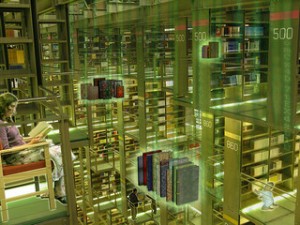 I remember as a graduate student in an on-campus program admitting to a colleague that I had never been in the library. This confession was met with shock and dismay, and a lack of awareness of exactly how much access I had to the library collection online. Locating and retrieving articles from the comfort of my desk was so much more efficient and appealing than finding a parking space, searching the stacks, and making photocopies – but this approach wasn't the norm.
I remember as a graduate student in an on-campus program admitting to a colleague that I had never been in the library. This confession was met with shock and dismay, and a lack of awareness of exactly how much access I had to the library collection online. Locating and retrieving articles from the comfort of my desk was so much more efficient and appealing than finding a parking space, searching the stacks, and making photocopies – but this approach wasn't the norm.
The national Digital Public Library of America‘s (DPLA) open access approach will not only increase your ability to use these materials in your online courses, it also hopes to reach a much larger audience. The goal of the DPLA, a collaborative effort in the works since the 1990s, is the "realization of a large-scale digital public library that will make the cultural and scientific record available to all." This is not a brand new project, but is seeing a surge of recent activity just ahead of its official launch next month.
My first experience with library databases was a decade ago, and the holdings of online libraries have grown exponentially since that time. As an online learner or instructor, no doubt you have developed skills in accessing research materials though your own institution's online databases. And access to articles and other publications is just the tip of the iceberg. EducationDive recently listed 12 technologies that will reshape school libraries, including new ways to communicate with librarians and search for materials, as well as improved services for distance learners. The DPLA adds to the resources available in a number of ways.
What can you expect?
When I first wrote about the DPLA in 2011, it was in the early stages of design, and just one example of the ways academic libraries are changing. Since then the vision has taken steps toward reality with potential benefits for online teaching and learning. Here are a few of the components to look for as the project continues to grow:
- Partnerships: The Smithsonian Institution is the latest organization to come on board announcing its participation earlier this week. It joins other groups, such as Harvard University, the National Archives, and the Digital Library of Georgia in creating a central entry point to a network of existing digital collections of artifacts, multimedia, and publications.
- Interdisciplinary Approach: The project was conceived of and is led by not only librarians and libraries, but also a wide range of educators, industry and government agencies, and museums.
- Library Expansion: The DPLA is not intended to replace your local or school library, but instead to augment it through aggregation of resources. American Libraries Magazine recently quoted Charles J. Henry, a member of the DPLA Steering Committee, as saying that "instead of 150,000 books available, [you] would have 50 million different objects," including recordings, manuscripts, and more.
The project continues to overcome challenges related to "technical standards, disorganized and incomplete metadata, and a host of legal issues." There are also potential problems in creating digital versions of some special collections due to the age or delicate nature of these items. It may not be realistic to expect that all holdings would eventually be available online, but progress is being made to make the DPLA a central hub with open access to as many items as possible.
Make the Connection
Stay tuned to the latest developments by connecting with the DPLA on Twitter and Facebook.
Recent updates include announcements about partnerships, introduction of the new executive director, and details of the official project launch taking place on April 18th and 19th. You may also want to add the DPLA blog to your reading list.
Get Involved
One of the primary elements of the DPLA plan is the development of a community working through "a participatory platform that facilitates the involvement of the public in all aspects of design, development, deployment, maintenance, and support." Hundreds of people have already been involved, and there are opportunities for you to join the collaborative effort. Check out the many ways in which you can participate in the project's development by sharing your ideas, joining a work group, and attending local and virtual events. Internships and research assistant opportunities are also anticipated for the future.
What does online access to research materials mean to you? Explore the resources available at the DPLA and share your thoughts with us here.
Image credit: HacksHaven, Flickr, CC:BY-NC-SA